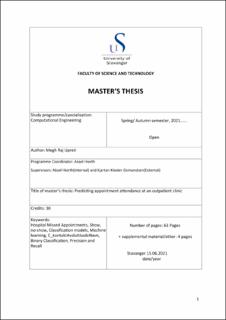| dc.description.abstract | Abstract
Background and aim: No-show, refers to patients who do not show up in the scheduled appointment, which is a serious problem for many years in the hospital. Also, the no-show rates differ in countries because of the different care systems and medical facilities. This study aims to understand the characteristics of the patient who miss the appointments, analyze their data, and come up with suitable prediction models.
Methods: The study consists of primary research.The main research is based on quantitative data
that aims to analyze Helse vest data and compare different binary classifiers and choose the best
model that fits the hospital’s business objective. CRISP-DM Methodology was preferred for the data mining process. The dataset consists of 61 columns and for data privacy reasons Age and date were not provided. Also, an SMS reminder sent was not available to use for the analysis due to GDPR.
Results: In the data analysis part, 9.44% missed the appointments( Ikke møtt/Ingen beskjed), 10.57% cancel the appointment and 79.97% came for the appointment(Ordinært avsluttet). The result for analysis shows that young people aged 20-29 missed most appointments.
Regarding days, Monday was the top-performing day for scheduling appointments. Thursday is the most missed appointment day and November is the most missed appointment month whereas least July is the least missed appointment. Precision was highest for Random Forest with 89.56% correctly predicted as a show and the values were actual show, whereas recall was highest for GaussianNB which was 80.87% which means out of all show, 80.87% was predicted show.
Conclusion: Patients aged 20-29 missed most appointments. Random Forest is better among all in terms of distinguishing between shows and no shows. However, solving this issue fully is challenging. In a nutshell, it would be well served to develop an understanding of the situation and business objectives under which each evaluation metric should be utilized. | |
